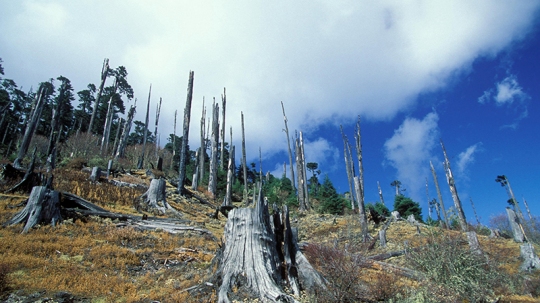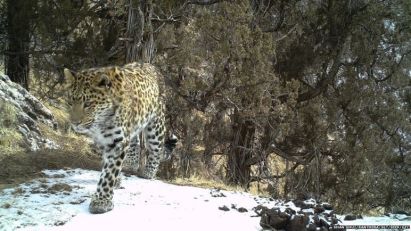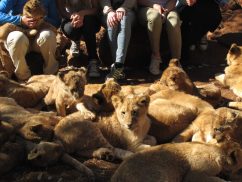Will Rainforests be a Thing of the Past 100 Years From Now?
Thirty years ago, a wide belt of rainforest circled the earth, covering Latin America, southeast Asia, and Africa. However, today, it is being rapidly replaced by great swathes of palm oil trees and rubber plantations, land cleared for cattle grazing, soya farming, expanding cities, dams, and logging. At current rates of deforestation, scientists are estimating that rainforests will vanish altogether in a century unless poor nations are helped to preserve them.
For thousands of years, people have been deforesting the tropics for timber and farming, but that is nothing compared to how humans have been physically transforming the Earth these past few centuries. Every year, about 18 million hectares of forest – an area the size of England and Wales – is felled. It is estimated that in the past forty years, possibly 1 billion hectares has been cleared. That’s equivalent to the size of Europe.
Based off of the latest satellite analysis, half the world’s rainforests have been razed in the past century. Particularly in the last 15 years, new hotspots have emerged globally from Cambodia to Liberia.

With trees being destroyed relentlessly, the chances of slowing or reversing climate change is becoming slimmer and slimmer. Tropical deforestation causes carbon dioxide, the main greenhouse gas, to linger in the atmosphere and trap solar radiation, raising global temperatures and leading to climate change. Therefore, deforestation in Latin America, Asia, and Africa can affect rainfall and weather everywhere from the US, to Europe, and to China.
The world’s atmospheric scientists have come to a consensus that about 12% of all man-made climate emissions comes from deforestation, mostly in tropical areas. The carbon locked up in Democratic Republic of the Congo’s 150 million hectares of forests are nearly three times the world’s global annual emissions.
And as the forests are destroyed, the native people who depend on the them become impoverished. Not only are the world’s rainforests provide food, energy security, incomes and medicinal plants for 300 million people, but they are also home to the richest wildlife in the world.
However, plans have already been made and in place for changes to be made. All countries formally pledged at the Paris climate summit in December 2015 to reduce emissions and keep global temperature rises to well below 2 Celsius, and in doing so, recognizing that this would not be possible without stopping or at least reducing tropical deforestation.
The 50 or more developing countries who share the world’s tropical forests all recognize their contribution and promised to crack down on illegal forestry, replant trees, and restore degraded forest lands.
Some countries were highly ambitious. China, Brazil, Bolivia and Congo DRC together put forward targets that could protect over 50 million hectares of forest over the next 15 years, an area the size of Spain. Indonesia, the world’s sixth largest carbon emitter, promised to cut its emissions by 29% by ending illegal deforestation and restoring 12 million hectares of forested land. Ecuador said that it planned to restore 500,000 hectares of forest land by 2017 and then increase that amount by 100,000 hectares a year. Honduras committed to plant or restore 1 million hectares of forest by 2030.
If countries stick to their pledges and let damaged forests recover, annual global greenhouse gas emissions could be reduced by as much as 24 to 30%.
But there’s one catch. Countries with tropical forests are some of the poorest in the world, desperate to develop and use their natural resources to grow their economies. Their pledges to stop or reduce deforestation are mostly conditional on rich countries financially. First world rich countries pledged at Paris to raise $100 billion a year to help these countries reduce their emissions of which a portion will go to tropical forest protection.
In addition, a new UN-backed mechanism called Redd (reduced emissions from deforestation and forest degradation) has been initiated that involves rich countries paying countries to protect forests and the carbon stored within them. Germany, Norway, and the UK have together promised up to $1 billion a year for Redd schemes until 2020 and the World Bank plans to contribute a similar amount to be given to African countries. Tropical and subtropical countries could receive both public and private funding if they succeed in reducing their emissions from deforestation. But this is deeply controversial as global schemes are prone to corruption, difficult to implement and hard to measure.
Until Paris, stopping tropical deforestation was at best unlikely and probably impossible. It remains very difficult, but a political and financial mechanism has now been created to incentive countries, companies ,and communities to do so at a fraction of the cost of reducing comparable emissions in the US or Europe. Protecting the forests now depends on rich governments not ducking their responsibilities and playing their part.
We are Destroying Rainforests so Quickly They may be Gone in 100 Years
Google Lays Bare Overlooked Deforestation ‘Hotspots’
Evidence of Rival Cats Challenging the Snow Leopard for Its Ever-Shrinking Range
Images captured in western China last year suggest the reigning big cat of high-elevation Central Asia – that grey ghost called the snow leopard – may be getting some company. That is, the common leopards (likely of the North Chinese subspecies) might be occupying the same area. It is the first time such direct habitat overlap has been documented on the Tibetan Plateau. Video footage can be found n the links provided below.


Furthermore, among the common leopards recorded was a female with a cub, suggesting that the new cats in town are not just exploring, they could be establishing themselves on the mountains as well.
So conservationists are worried about the future of the snow leopard’s survival if common leopards begin to live at higher elevations in a warming climate. Snow leopards are sub-alpine and alpine specialist with substantially less ecological room to adapt than its larger, yellower, and more adaptable relative who inhabits a variety of ecosystems across their enormous geography.
If the two cats share the same home, there will be competition for prey.
In Nepal’s Sagarmatha National Park – which includes Mount Everest in its bounds – research has revealed extensive dietary overlap between the two cats, with both favouring Himalayan tahr (a goat-antelope), musk deer and domestic livestock. But, Sargarmatha’s spotted cats, despite their shared menu, are mostly segregated themselves by habitat with snow leopards preferring alpine shrublands and grasslands while common leopards favoring the forest belt below. And because tahr, musk deer and cattle seasonally drift between these areas, both common and snow leopards can stalk the same quarry in their respective preferred haunts.
But as Himalayan forests “climb” the mountainsides in response to increasing temperatures, common leopards may move with them – possibly ramping up competition between the two cats.
And that’s just one part of the snow leopard’s habitat woes. As suitable territory between timberline and mountaintop shrinks, the cats could also hit a physiological ceiling on their climb upslope, where lack of oxygen would block their way.
“In a changing climate, we expect the tree line to move up the slopes and that’s encroaching into the snow leopard’s habitat,” said Byron Weckworth, China programme director with Panthera, a conservation organisation dedicated to preserving wild cats.
Some studies suggest that between 30% and 50% of the current snow leopard habitat in the Himalayas will be lost because of the shifting tree line and the shrinking of the alpine zone.
“The bigger threat is the snow leopards’ habitat loss and its fragmentation,” said Mr Weckworth, whose organisation has partnered with the Snow Leopard Trust and Chinese conservation organisation Shan Shui to monitor wildlife in China’s Sanjiangyuan nature reserve.

Only 3,500 to 7,000 snow leopards likely remain in the heights of Central Asia from Russia in the north to Bhutan in the south, and from Afghanistan in the west to China in the east. A study from last year suggested that the high-country prowler could lose as much as half of its current territory to global warming by 2070.
While some conservationists fear that there might be conflicts between the two leopard species for habitat and prey, others think the two already co-exist in places where their territories overlap.
Mr Weckworth said their research team in China found locals believing that the two species could even mate. However, he states that because “the common leopards there are more pale in color. But from a biological point of view, it’s extremely unlikely that they can hybridize.
The common leopard isn’t the only fellow big cat to occasionally tread into the snow leopard’s kingdom. In Jigme Dorji National Park in Bhutan’s Himalaya, for example, Bengal tigers have lately been recorded beyond 13,000 feet – even killing Himalayan black bears up there. Researchers suspect warming temperatures and rising timberlines might explain the appearance of the striped cats at such elevations, although human persecution and habitat loss in the lowlands could also be a driving force.
This issue will be high on the agenda of an international meeting involving 12 snow leopard range countries starting in Nepal on Tuesday, 17 January.
Climate Change Brings Rival Cats to the Snow Leopard’s Neighborhood
Concerns over First Snow and Common Leopards Found in the Same Area
Controversy Over South Africa’s New Canned Lion Export Quota

With growing concern over the canned lion trade, South Africa’s Department of Environmental Affairs plans to establish an annual quota of 800 for the export of skeletons from farm-bred lions and won’t authorize shipments until one has been put in place.
Albi Modise, a spokesman for the department, stated that permits will only be granted when a scientific authority decides that it won’t be detrimental to the survival of the species. The export quota for captive lions may help prevent the poaching of wild lions as demands surges for lion bones with Asian countries better protecting tigers.
“Well-regulated trade will enable the department to monitor a number of issues, including the possible impact on the wild populations,” Modise said. The quota proposal will be sent to the United Nations’ Convention on the International Trade in Endangered Species (CITES) for approval.
Carla van der Vyver, the chief executive officer of the South African Predator Association, which represents lion farmers, believes that the quota should be higher than 800 skeletons, saying that the trade will only diminish the threat to wild lions. “If there is a regulated, consistent supply at a reasonable price, it reduces the likelihood of illegal traders getting the opportunity to supply the market at prices that make illegal trade worthwhile.”
However, not everyone agrees with the Department that the quota will protect the wild lion populations.
“Four Paws opposes the Department of Environmental Affairs’ recommendation,” Fiona Miles, country director of conservation group Four Paws South Africa, said. There should be a “total suspension of trade in captive lions and their bones” and an end to captive-lion breeding in order to protect the species, she said.
Today, as few as 20,000 individuals occupy just 8% of their historic range across Africa. The species is listed as “vulnerable,” with populations in West Africa classified as “critically endangered.” In 2016, the IUCN estimated that lions had declined by approximately 43% over the previous 21 years and since the film Born Free in 1966, Africa’s lions have declined by at least 80%.
Though loss of habitat, reductions in prey species, and conflict with human communities are the major threats of lion decline, increasing international trade in lion body parts have been recognized as a main threat by countries with lion populations. Lion bones have been recently been substituted for tiger bones in medicinal remedies used in East Asia.
As a result, last October of 2016 at the CITES’ annual meeting in Johannesburg, South Africa, all participating countries agreed to ban international trade in bones and other body parts from wild lions. However, South Africa was permitted to continue trading the body parts of captive-bred lions provided it established an annual quota.

Commenting on the proposed quota, international wildlife charity Born Free Foundation’s president, Will Travers, said: “It seems the South African authorities have crumpled in the face of pressure from commercial lion breeders…In proposing an export quota of 800 skeletons, the authorities have assumed, wrongly in my view, that the trade will have no impact on wild lions, without any evidence to back that up…”
“Born Free and many conservation organisations believe that the trade will further stimulate demand in Asia for lion bones and perpetuate the demand for tiger bone tonics which often contain lion bone. This will, in turn, put already beleaguered wild tigers, as well as lions, at greater risk from poachers seeking a quick profit by laundering bones from wild lions and other big cats into the trade. South Africa’s commercial lion breeding industry is unspeakably cynical and cruel, poses a threat to wild lions and other big cats, and needs to be shut down.”
As many as 8,000 lions and other big cats are kept on 200 or more breeding farms, according to wildlife charity Born Free Foundation. Lion skeletons can sell for more than $2,000 each with consumers in Asia paying “far higher” prices than that, according to the organization.
The South African National Biodiversity Institute will start a three-year study to monitor lion bone trade in South Africa and investigate how the trade in bones from captive lions using a quota system affects wild lion populations, Modise said. The public has until Feb. 2 to comment and a final quota will be sent to CITES in March.
Lion Farmers May Get Skeleton Export Quota in South Africa
International Trade in 800 Lions from Controversial ‘Canned Hunting’ Industry
Why South Africa’s New Lion Skeleton Export Quota Spells Disaster for This Endangered Species
